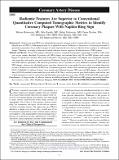| dc.contributor.author | Kolossváry, Márton | en_US |
| dc.contributor.author | Karády, Júlia | en_US |
| dc.contributor.author | Szilveszter, Bálint | en_US |
| dc.contributor.author | Kitslaar, Pieter | en_US |
| dc.contributor.author | Hoffmann, Udo | en_US |
| dc.contributor.author | Merkely, Béla | en_US |
| dc.contributor.author | Maurovich-Horvat, Pál | en_US |
| dc.date.accessioned | 2018-02-26T20:40:20Z | |
| dc.date.issued | 2017 | en_US |
| dc.identifier.citation | Kolossváry, Márton, Júlia Karády, Bálint Szilveszter, Pieter Kitslaar, Udo Hoffmann, Béla Merkely, and Pál Maurovich-Horvat. 2017. “Radiomic Features Are Superior to Conventional Quantitative Computed Tomographic Metrics to Identify Coronary Plaques With Napkin-Ring Sign.” Circulation. Cardiovascular Imaging 10 (12): e006843. doi:10.1161/CIRCIMAGING.117.006843. http://dx.doi.org/10.1161/CIRCIMAGING.117.006843. | en |
| dc.identifier.issn | | en |
| dc.identifier.uri | http://nrs.harvard.edu/urn-3:HUL.InstRepos:34868843 | |
| dc.description.abstract | Background— Napkin-ring sign (NRS) is an independent prognostic imaging marker of major adverse cardiac events. However, identification of NRS is challenging because of its qualitative nature. Radiomics is the process of extracting thousands of quantitative parameters from medical images to create big-data data sets that can identify distinct patterns in radiological images. Therefore, we sought to determine whether radiomic analysis improves the identification of NRS plaques. Methods and Results— From 2674 patients referred to coronary computed tomographic angiography caused by stable chest pain, expert readers identified 30 patients with NRS plaques and matched these with 30 non-NRS plaques with similar degree of calcification, luminal obstruction, localization, and imaging parameters. All plaques were segmented manually, and image data information was analyzed using Radiomics Image Analysis package for the presence of 8 conventional and 4440 radiomic parameters. We used the permutation test of symmetry to assess differences between NRS and non-NRS plaques, whereas we calculated receiver-operating characteristics’ area under the curve values to evaluate diagnostic accuracy. Bonferroni-corrected P<0.0012 was considered significant. None of the conventional quantitative parameters but 20.6% (916/4440) of radiomic features were significantly different between NRS and non-NRS plaques. Almost half of these (418/916) reached an area under the curve value >0.80. Short- and long-run low gray-level emphasis and surface ratio of high attenuation voxels to total surface had the highest area under the curve values (0.918; 0.894 and 0.890, respectively). Conclusions— A large number of radiomic features are different between NRS and non-NRS plaques and exhibit excellent discriminatory value. | en |
| dc.language.iso | en_US | en |
| dc.publisher | Lippincott Williams & Wilkins | en |
| dc.relation.isversionof | doi:10.1161/CIRCIMAGING.117.006843 | en |
| dc.relation.hasversion | http://www.ncbi.nlm.nih.gov/pmc/articles/PMC5753832/pdf/ | en |
| dash.license | LAA | en_US |
| dc.subject | Coronary Artery Disease | en |
| dc.subject | angiography | en |
| dc.subject | atherosclerosis | en |
| dc.subject | chest pain | en |
| dc.subject | coronary artery disease | en |
| dc.subject | multidetector computed tomography | en |
| dc.title | Radiomic Features Are Superior to Conventional Quantitative Computed Tomographic Metrics to Identify Coronary Plaques With Napkin-Ring Sign | en |
| dc.type | Journal Article | en_US |
| dc.description.version | Version of Record | en |
| dc.relation.journal | Circulation. Cardiovascular Imaging | en |
| dash.depositing.author | Karády, Júlia | en_US |
| dc.date.available | 2018-02-26T20:40:20Z | |
| dc.identifier.doi | 10.1161/CIRCIMAGING.117.006843 | * |
| dash.contributor.affiliated | Karady, Julia | |
| dash.contributor.affiliated | Hoffmann, Udo | |


